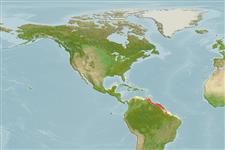Élasmobranches (requins et raies) (sharks and rays) >
Myliobatiformes (Stingrays) >
Dasyatidae (Stingrays) > Urogymninae
Eponymy: Dr Dirk Cornelis Geijskes (1907–1985) was a biologist, ethnologist and entomologist. [...] (Ref. 128868), visit book page.
Environment: milieu / climate zone / depth range / distribution range
Écologie
marin; saumâtre démersal; profondeur 5 - 80 m (Ref. 114953), usually 5 - 25 m (Ref. 5217). Tropical
Western Central Atlantic: patchy distribution, from Belize to northern Brazil.
Taille / Poids / Âge
Maturity: Lm ? range ? - ? cm
Max length : 150 cm WD mâle / non sexé; (Ref. 5217); common length : 70.0 cm WD mâle / non sexé; (Ref. 5217)
Disc is narrowly projecting to snout, pelvic fins with long anterior margins. Narrowly pointed falcate outer corners. Upper surface dark brown, lower surface pale with darker margins and teeth as yellowish white (Ref. 6902).
Found in shallow waters on sandy bottoms generally between 5 and 25 m depth. Reported from a depth of 810 m (Ref. 13608). Ovoviviparous (Ref. 50449).
Life cycle and mating behavior
Maturité | Reproduction | Frai | Œufs | Fécondité | Larves
Exhibit ovoviparity (aplacental viviparity), with embryos feeding initially on yolk, then receiving additional nourishment from the mother by indirect absorption of uterine fluid enriched with mucus, fat or protein through specialised structures (Ref. 50449). Distinct pairing with embrace (Ref. 205).
Cervigón, F., R. Cipriani, W. Fischer, L. Garibaldi, M. Hendrickx, A.J. Lemus, R. Márquez, J.M. Poutiers, G. Robaina and B. Rodriguez, 1992. Fichas FAO de identificación de especies para los fines de la pesca. Guía de campo de las especies comerciales marinas y de aquas salobres de la costa septentrional de Sur América. FAO, Rome. 513 p. Preparado con el financiamento de la Comisión de Comunidades Europeas y de NORAD. (Ref. 5217)
Statut dans la liste rouge de l'IUCN (Ref. 130435: Version 2024-1)
Menace pour l'homme
Venomous
Utilisations par l'homme
Pêcheries: intérêt commercial mineur
Outils
Articles particuliers
Télécharger en XML
Sources Internet
Estimates based on models
Preferred temperature (Ref.
123201): 27 - 28.3, mean 27.6 °C (based on 302 cells).
Phylogenetic diversity index (Ref.
82804): PD
50 = 0.5156 [Uniqueness, from 0.5 = low to 2.0 = high].
Bayesian length-weight: a=0.01023 (0.00486 - 0.02155), b=3.06 (2.87 - 3.25), in cm total length, based on LWR estimates for this (Sub)family-body shape (Ref.
93245).
Niveau trophique (Ref.
69278): 3.7 ±0.3 se; based on size and trophs of closest relatives
Résilience (Ref.
120179): Faible, temps minimum de doublement de population : 4,5 à 14 années (Assuming fecundity<100).
Fishing Vulnerability (Ref.
59153): Very high vulnerability (90 of 100).
